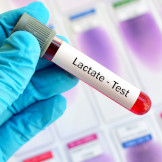Tredict is able to detect the following capacity values automatically when a workout exceeds certain trigger values.
Automatic detection of:
- Functional Threshold Pace (FTPa)
- Functional Threshold Power (FTP)
- Lactate Threshold Heart Rate (LTHR)
- Maximum Heart Rate (hrMax)
In case of a hit, the new capacity value will be displayed in the detailed view of the activity with a hint and you can transfer this value to a new revision associated with the training date.
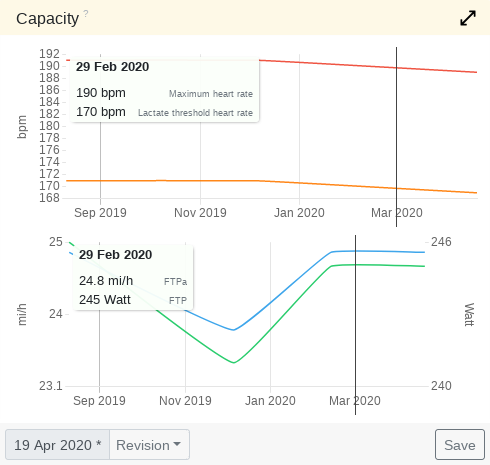
A revision with capacity values
The automatic determination of Functional Threshold and Lactate Threshold is triggered by looking at the relationship to the maximum heart rate.
Therefore, it is important that your maximum heart rate has been determined correctly in order to get precise results.
Accurate capacity values allow you to keep your zone revisions precise and up-to-date.
Well adjusted zones, on the other hand, give you an overview of which intensity ranges you are in during your training. Therefore it is important to know the maximum heart rate, the lactate threshold and also the Functional Threshold Pace (FTPa) and to keep it up-to-date over time. The capacity values are subject to larger and smaller fluctuations because your form can never remain the same over the year. The revision model allows you a period based adjustment of your capacity values and zones.
What is the maximum heart rate?
The heart beat frequency is controlled by the neuromuscular system of your body. During prolonged, maximum effort, your nervous system will control the heart's pumping power and pumping frequency to the maximum. In healthy people, without damage to the heart. This is the maximum heart rate.
Even higher frequencies can occur due to pathological and life-threatening ventricular fibrillation, even without physical activity.
For healthy people, it is safe to exercise at maximum heart rate for longer periods of time.
However, this represents a considerable mental challenge, as it can of course be painfully exhausting. The maximum heart rate, in combination with your resting pulse, is already a small hint of your possible performance reserve and is an important base value for the evaluation of your training intensities.
Determine maximum heart rate
The maximum heart rate of each workout is determined from the HR5s.
The HR5s is the maximum 5 second average value in the time series of the heart rate. Tredict looks if the HR5s of the training is higher than the maximum heart rate in the revision period of the training date.
If so, you will get a message dialog with the possibility to accept the detected value.
In order for the determined value to match the actual maximum heart rate, the training should have had very strenuous passages where you went to your limits.
The possible maximum heart rate decreases with age by about one beat per year, therefore this capacity value should be manually corrected downwards every year. Tredict can only recognize when a new higher maximum heart rate is available.
In the evaluation category you can determine the HR5s' of a selected period in the maximum average values of the heart rate.
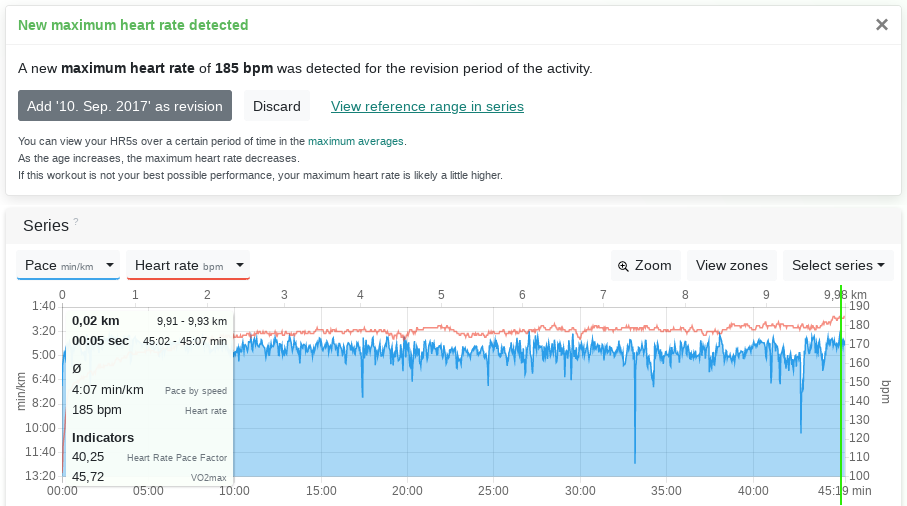
A new maximum heart rate was detected in the training series
What is the Functional Threshold Pace?
The Function Threshold Pace is the speed that you can maintain in about 60 minutes without collapsing or becoming dysfunctional.
This value is a referential capacity and performance measure and gives you an indication for your competition and training speeds.
The FTPa is often incorrectly called CPA60. CPA60 means Critical Pace over 60 minutes and is mostly determined deterministically by your training activities. The equation of Functional Threshold Pace and Critical Pace 60 is misleading, because in the normal everyday life of an athlete you will never reach a CPA60 that comes close to the true FTPa.
Automatic determination of Functional Threshold Pace (FTPa)
20-minute test
The "20 minute test" consists of a warm-up phase with 2-3 medium 3-minute intervals, then continue 5 minutes loosely, then 5 minutes full power, now continue 10 minutes loosely and then 20 minutes total out, the last 5 minutes must really go beyond your pain threshold. Afterwards cool down with a beer.
Tredict should now show you your exact FTPa, FTP and LTHR, if it has changed.
For the per mil value please call your local police station.
For the automatic determination of the FTPa, the workout must meet certain requirements to exceed the trigger values.
Tredict looks at the following maximum average speed values and determines the average heart rate in these ranges. These must exceed a certain percentage in relation to maximum heart rate.
The base value is the maximum heart rate in relation to the average heart rate of the measurement range of the fastest speed in the range period:
- PA60 : hrMax% > 0.85
- PA20 : hrMax% > 0.88
- PA5 : hrMax% > 0.91
- PA3 : hrMax% > 0.92
Depending on the amount of hrMax%, correction factors are then applied to the determined FTPa.
The accuracy of the determined FTPa depends on a correct maximum heart rate and on the evenness of the track. An exact FTPa can therefore only be determined on a flat track.
It would be modern to use Artificial Intelligence (AI) and Machine Learning (ML) to calculate the deviation of the maximum heart rate and the unevenness of the track or to rely blindly on the grade adjusted pace. However, in "long series of tests" we have found an even more modern method -> Natural intelligence in front of the screen!
If you want to measure your FTPa very accurately, you can either participate in a flat 30-60 minute strenuous competition or you can take the so-called "20 minute test" on a flat track. Tredict can then determine a very exact FTPa from these activities.
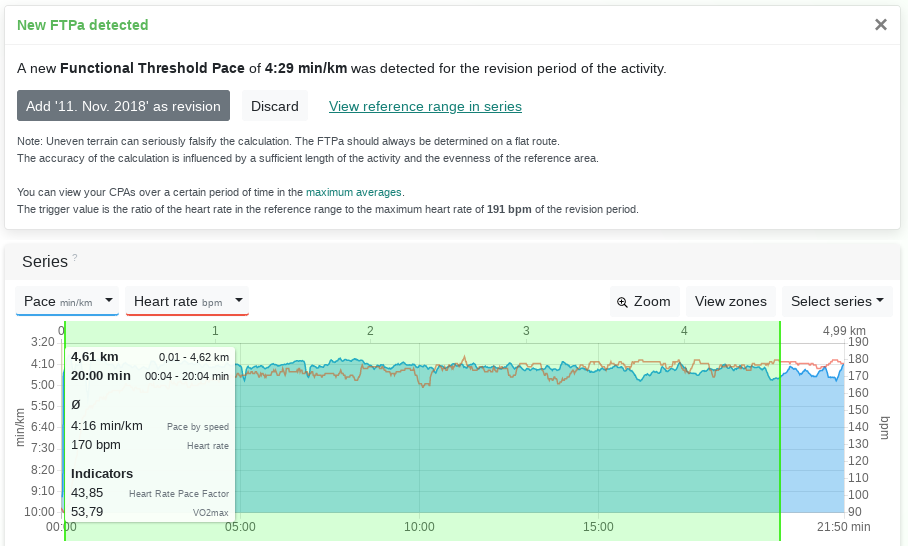
A new Functional Threshold Pace was detected in the training series
What is the Functional Threshold Power?
The Functional Threshold Power is the wattage that you can maintain for about 60 minutes without collapsing or becoming dysfunctional.
This value is a referential capacity and power value and gives you an indication of your competition and training speeds.
Like FTPa, FTP is often incorrectly called CP60. CP60 means Critical Power over 60 minutes and is mostly deterministically determined by your training activities. The equation of Functional Threshold Power and Critical Power 60 is misleading, because in the normal everyday life of an athlete you will never reach a CP60 that comes close to the true FTP.
Automatic determination of Functional Threshold Power (FTP)
The determination of the FTP works similar to the determination of the FTPa.
Tredict looks at certain maximum average wattage values and determines the average heart rate in these ranges.
The base value is the maximum heart rate, in relation to the average heart rate of the measuring range of the highest wattage in the range period:
- P60 : hrMax% > 0.85
- P20 : hrMax% > 0.88
- P5 : hrMax% > 0.91
- P3 : hrMax% > 0.92
Depending on the amount of hrMax%, correction factors are then applied to the determined FTP.
The accuracy of the determined FTP depends on a correct maximum heart rate and on the evenness of the measurement range.
As with the FTPa, you can take part in a shorter competition or take the "20 minutes test" described above so that Tredict can give you a very accurate FTP.
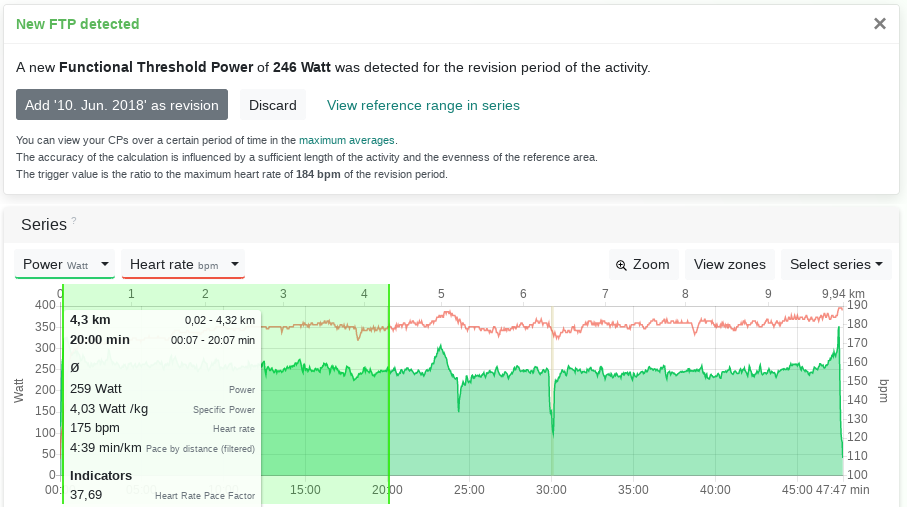
A new Functional Threshold Power was detected in the training series
What is the lactate threshold heart rate?
The lactate threshold value heart rate defines the heart rate range at which the oxygen utilization of the body is just sufficient to compensate for oxygen consumption.
Around the lactate threshold, the anaerobic load range begins, at which increased lactate is formed by low-oxygen energy production.
The lactate threshold is also often referred to as the aerobic-anaerobic threshold. For many athletes, however, this value is fluid, no switch is flipped, and one should actually speak of a lactate threshold range.
Automatic determination of the Lactate threshold heart rate (LTHR)
For the automatic determination of the lactate threshold heart rate (LTHR), the ratio of the CPA20 of the training to FTPa or the CP20 to FTP is compared. If the Critical Power 20 is available, it is preferred.
To trigger a detection, the CP20-FTP ratio must be above 89%. Additional filter factors are applied. The last 15 minutes of the CP20 are then evaluated as lactate threshold heart rate and you can use them in a revision of the training period.
Again, the accuracy depends on the uniformity of the measuring range and whether you have warmed up sufficiently before.
For a very accurate result it is a good idea to take a "20 minute test" or simply to take part in a crisp competition.
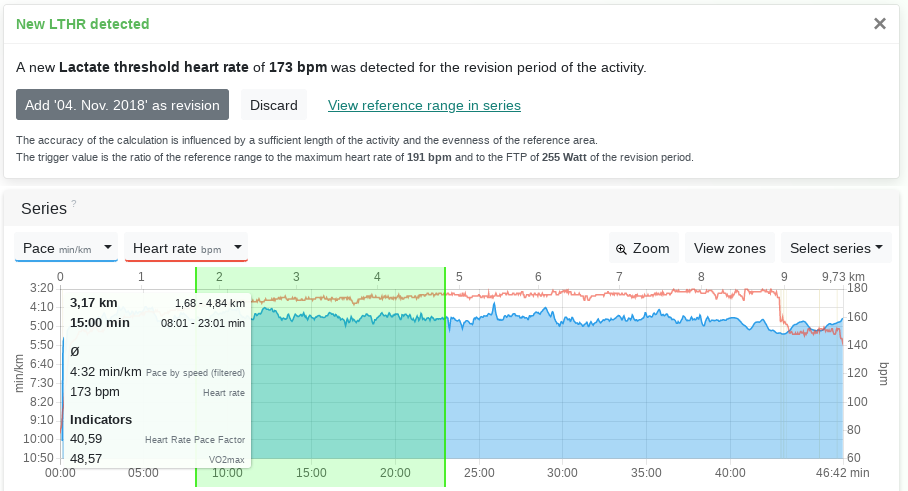
A new Lactate Threshold Heart Rate was detected in the training series
Conclusion
If you have done a sufficiently strenuous training, Tredict is able to tell you your lactate threshold and functional thresholds automatically. You can then take these values into a revision of your capacity values and monitor your athletic performance, set the zones precisely and plan your competitions better in advance.
